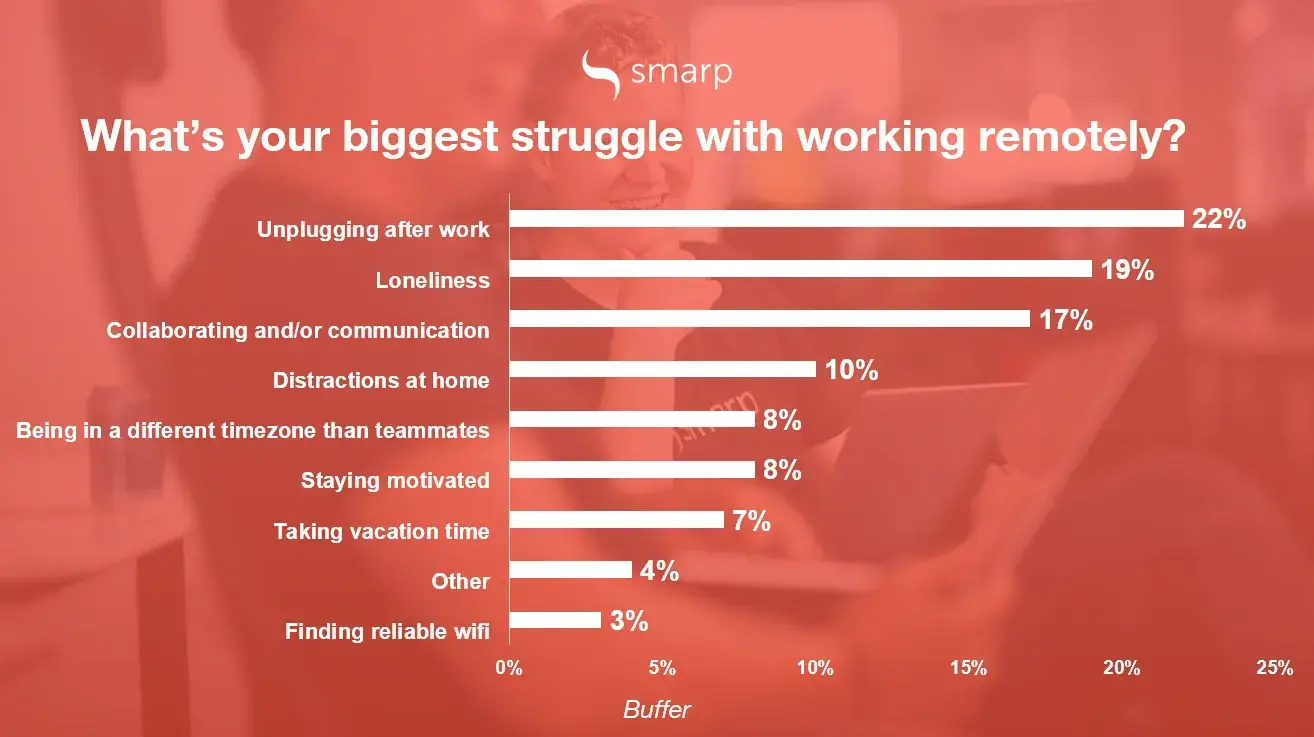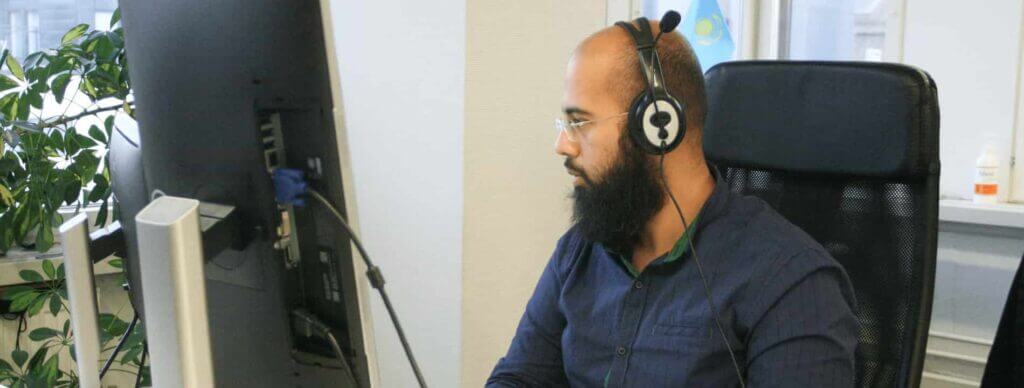As the number of remote workers is increasing exponentially, employers are now addressing remote work more than ever before.
In this blog, we will discuss some of the most common remote work challenges as well as the ways you can help your remote employees be more successful in their jobs.
💡Download the Skillset Map of a Modern IC Department and learn about the most required leadership skills for modern communication practitioners!
The Rise of Remote Work
Remote work is not just another trend, it is become the norm in most companies. According to Buffer’s research on remote work, 99% of employees say that they would like to work remotely at least some of the time for the rest of their careers. Moreover, 91% of the surveyed companies said that they had always intended to support remote work.
Since 30% of companies say that all their employees are working remotely, now is the time to talk more about how we can make remote work better in the future and help your remote employees excel at their work.

Top Remote Work Challenges
There has been a lot of research done on the advantages and disadvantages of remote work. Let’s take a look into some of the most common challenges that remote employees are facing today.

1. Communication
HBR found that remote employees often feel left out and disconnected :
“Remote employees are more likely to report feeling that colleagues mistreat them and leave them out. Specifically, they worry that coworkers say bad things behind their backs, make changes to projects without telling them in advance, lobby against them, and don’t fight for their priorities”.
That’s the reason why proper, frequent and transparent communication through the right channels is extremely important when it comes to communicating with remote teams.
Luckily, employee communication solutions like Smarp make workplace communication with remote workers much more efficient.
2. Unplugging after work
Many managers may fear that their remote employees don’t do their jobs responsibly.
However, this is often not the case. Indeed, many remote employees struggle with unplugging after work. When a remote worker’s personal life and work are both under the same roof, it’s hard to “switch off.”
3. Team collaboration
It is harder to collaborate with your teammates when you rarely see them in person or don’t have the right employee communications solution in place.
Unfortunately, there are still companies that expect their employees to communicate and collaborate on projects through emails.
Employers need to find a better way to help remote employees collaborate with their colleagues and ease interdepartmental collaboration.

4. Interruptions
Interruptions can be another negative side of remote work. Interruptions such as doorbell, neighbors or just a poor internet connection can hurt remote employees’ focus and productivity.
On the other hand, some employees feel they are more productive when working from home. Working in an open space, for example, where workplace conversations are happening all the time can harm employee productivity.
5. Isolation
While some remote employees struggle with interruptions, for others isolation may be the biggest disadvantage of remote work.
It is too easy to get the habit of working from home all day, and then remain in your home for the remainder of that day and sometimes for subsequent days.
People who work in shared offices experience “watercooler” moments of interaction and even have lunch together or go for after-work drinks. Remote workers, on the other hand, often work asynchronously with their teammates and sometimes don’t even have anyone to talk to.
6. Being out of the loop
One of the main reasons for dissatisfaction among remote workers is the feeling of not being in the loop with important company news and events. Many also feel like they are missing out on important information.

Often, this results in low employee satisfaction, engagement and productivity levels. Many employees feel like they are not informed enough about their company, and this is especially true for remote and non-wired employees.
Read on: 8 Employee Engagement Statistics You Need to Know in 2020 [INFOGRAPHIC]
7. Time zone differences
It is not unusual today for global companies to have a lot of remote employees in different time zones. These differences make it harder for employees to communicate and deliver projects on time.
7 Ways How to Set Up Your Remote Workers for Success
Now that we have covered some of the biggest disadvantages of remote work, let’s take a look at best practices for improving your remote employees’ experience.
1. Build trust in the workplace
Unfortunately, there are still many employees that don’t trust their employers and leaders. This lack of trust negatively influences employee experience, engagement and productivity.
Trust is even harder to build with remote employees as they don’t often see their teammates and managers and can’t take part in daily conversations that are happening in the offices.
One of the most effective ways to build trust and better relationships with remote workers is to communicate openly and frequently with them.
2. Encourage open and transparent communication
As seen earlier, poor and inefficient communication is one of the biggest disadvantages of remote work and one of the leading factors that create negative employee experience among remote employees.
To eliminate this challenge, employers must develop a company culture that welcomes honest and open communication in the workplace.
3. Help your employees unplug from work
Employee burnout is becoming a serious problem in the world of human resources. Organizations need to understand that 39% of employee burnout comes from work overload.
Therefore, we see more and more employers addressing issues around these topics.
As remote employees struggle to unplug from work, employers need to ensure that employees are aware of the negative consequences of overwork and burnout.
Organizations may implement new company policies that ensure normal working hours for remote workers and prevent them from experiencing burnout.
4. Ensure easy access to important information
Today, employees expect to get the right information at the right time.

Yet, according to a report on 2018 global workplace trends, there’s a major gap between the ease with which employees access data in their personal lives versus accessing valuable information from across the work organization.
As said in the same research,
“the consumer-grade technology experience employees are expecting at work is impeded by critical information being hard to access and nearly impossible to process. This is due in part to factors such as information silos, restricted permissions, and lack of centralized and updated content”.
So, are you ready for the #NoSearching revolution at your organization?
5. Listen to your employees
If you want your employees to communicate openly, they need to trust that their thoughts will be heard, appreciated, and acted upon.
As remote employees rarely have personal interactions with their colleagues and managers, they may sometimes feel like their voice is ignored.
Therefore, organizations need to put extra effort into listening to their remote employees and making sure that they see that their voice is valued and appreciated.
Read on: Top 15 Employee Motivation Tips and Benefits
6. Choose the right communication channels
Today, it is common to see large organizations using multiple internal communication channels. Most enterprises use the combination of tools such as emails, Intranets, collaboration tools and project management solutions.
As the internal communication ecosystem is getting more complex, employers need to be careful about how they use all those various channels.
To make sure that employees—including the remote ones—don’t miss out on important company information, businesses need to use a central communication platform with all the important information available at all times.
Smarp, our employee communication solution, is designed to help companies eliminate this challenge of managing their internal communication ecosystem. Smarp connects all of your communication channels into a single platform where employees can instantly access, share or comment on important updates.
7. Implement mobile-first communication solutions
It is important for employers to adapt their internal comms to their employees’ habits.
We are all aware that smartphones are millennials’ and gen Z’s preferred mean of communication and yet, some companies are not using mobile-first employee communication solutions to reach out to their employees and help them to better engage with their content.
Employers are now expected to provide a consumer-grade technology experience in the workplace with one-touch, mobile access to information and company updates that help employees work faster and smarter.
Read on: 5 Employee Communication Predictions for 2020 (And Beyond)
Use Smarp to Better Connect With Your Remote Employees
Smarp is an employee communications software that transforms and streamlines the way your workplace communicates and collaborates.
Being a high performer per G2Crowd reviews, Smarp is one of the leading internal communication solutions out there.
Its mobile-first approach enables employers to adjust to the new workplace trends and always make sure that office, remote and other non-wired employees always stay up-to-date with the important company updates.
Smarp’s user-friendliness and attractive design mimics social media news feeds that employees are already used to which significantly increases usage rates compared to emails and intranets.










